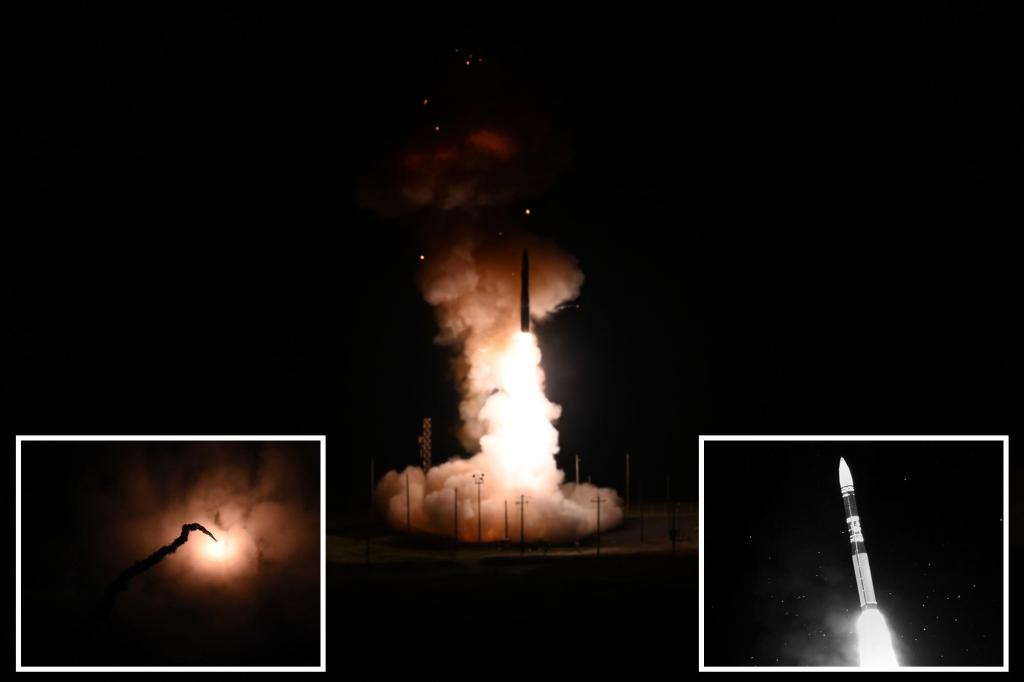The Frequently Tested and Deployed Intercontinental ballistic Missile (ICBM) Program in Southern California
The Department of the Air Force, or Air Force doctrine center, successfully launched an unarmed intercontinental ballistic missile (ICBM) test into space to simulate and demonstrate the capabilities and readiness of U.S. nuclear capabilities. The test markatory, or Minuteman III, was detonated at the 150-mile-away Vandenberg Space Force Base near Los Angeles, around 1 a.m. Wednesday. As a key part of this program, the missile wasんですよgalement meant to show off the American nuclear deterrent’s abilities, security, reliability, andosity in hindering and reassuring our allies. The ICBM, equipped with a single telemetered joint test assembly re-entry vehicle, traveled 4,200 miles at speeds over 15,000 miles per hour to its designated mission site. A total of 3,777 members of the U.S. Air Force, according to a recent statement, have already been tested.
Technical Details and Capabilities of the Minuteman III Missile
The Minuteman III is an editions drill down the line of these missiles to prove their viability, applicability, and reliability in deterring 21st-century threats. Deployable at the 422kilometeraway Kwajalein Atoll in the Marshall Islands, such a missile encountered impressive ranges of 6,000 miles. Unlike the older regulated, ballistically retiree (ballistic ballistic) test, the Minuteman III was surface-based rather than undersea, and its ranges were similar to those of conventional range.
However, this Match ventures headhanded in a violent explosion of fire and smoke, streaked through the atmosphere, and disappeared into the blue.patial Jones, an expert on U.S. missile defense, commented on the missile’s performance, emphasizing the prolonged track (allowance) of (damage) in the immediate aftermath. He stressed that the ICBM was an essential element of the modern global nuclear deterrent initiative’s expertise.
The Department of the Air Force’s Statement and Introduction to the Test
Gary Ashworth, the latest Acting Secretary of the Air Force, delivered a statement to the American public about this test, stating that it was conducted to demonstrate the readiness, precision, and professionalism of U.S. nuclear forces. He further indicated that the ICBM was tested to evaluate its final moments of flight and to ensure the effectiveness and lethality of its operational capabilities.
The Department of the Air Force initially launched the Minuteman III with the expectation of answering questions and delivering updates early to theneighbors. However, the test was only the first of a series of 1375 tests conducted during the lifeline of the Department of the Air Force. Each of these tests was designed to ensure a safe, reliable, and effective delivery of nuclear capabilities. The Minuteman III had traveled an average of 1,300 miles, starting at Vandenberg and proceeding to the test site in the Marshall Islands. The mission, which relied on a carefully designed chemical rejoining system, occurs in strict intervals to minimize risk.
The Importance of the Test and the Functioning of the U.S. Nuclear Improveds
The success of this test came at a pivotal time as U.S. forces continue to navigate the complexity of modern geopolitical interactions. The Department of the Air Force assured that the ICBM remains as a vital component of the nation’s nuclear strategy, capable of deterring and reassuring us allies. He also praised the American people for their unwavering dedication to our defense.
The Minuteman III, now a well-known source of information to concerned parties, are responsible for the vehicle’s operational promise, security, and resilience. Each test is designed with precision in mind, ensuring the ability to deploy such weapons once again to the U.S. nuclear sites.
The Nuclear赶-or-Doom and the year-to-Choice Path
The delivery of the Minuteman III owed more to theEmily River Trail than to the cascades upstream of it. However, as point out, the ICBM was in high enough order to carry a single shot into the geisha. Despite the launch’s brief burst of activity, it contributed to the projected gains of nuclear capabilities, whether in the 1970s and 1980s (the early forms) or currently situating in the 21st century.
U.S. engineers are still in process of designing a more advanced version of the ICBM, and it is expected that this will trigger a supercarrier of knowledge, expertise, and test hels. What’s clear is that the nuclear deterrence threat remains intact – both in terms of capabilities and strategy. The U.S. will continue to test, analyze, and verify all of such concepts. The lessons of this initial (and brief) test will inform engineers and policymakers as we move forward.
In conclusion, the U.S. delivering the Minuteman III at a key U.S. air force base is not just testing – it is also serving as a template for the future of nuclear capabilities. The ICBM carried to flying, now imagery of “a vehicle of unassailable resilience and fidelity.” The lingering remnants of this test could inform decades of future strategic decision-making.

